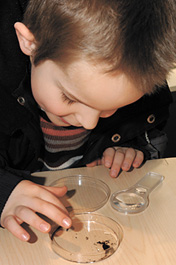MySci visits Mirowitz Day School
Published January 16, 2006
SPECIAL TO THE LIGHT
The 37-foot custom-built MySci Investigation Station trailer attracted a lot of attention and excitement at the parking lot at Saul Mirowitz Day School – Reform Jewish Academy. The unique experiential learning program for students in kindergarten through second grade in the Greater St. Louis Metropolitan area was made possible with a $3.7 million dollar investment from the Monsanto Fund and partnership with the Missouri Botanical Garden, St. Louis Science Center, St. Louis Zoo and Washington University. “This program is an excellent collaboration of corporations and institutions for the future of education,” said Washington University Science Outreach Faculty Skyler Harmann, a member of Central Reform Congregation, one of the MySci program specialists.
Students arriving in the specimen room of the three section trailer pointed out the confluence of the Missouri and Mississippi rivers created by the brown and blue carpet design on the floor. Everything is kid-sized and at their eye level: a learning environment created just for them. The small tables are surrounded by chairs resembling tree stumps with a leaf stamp on their tops. The room has X-rays of animals and displays of a variety of animals and insects. It is also equipped with state-of-the-art dissecting microscopes and Smart Boards.
At the learning station, students received magnifying glasses and individual petri dishes — one with a live earthworm and one with a live meal worm in it — to observe. Washington University Science Outreach faculty member Rosalynn LeNoir is also one of the MySci program specialists. She encouraged students to look for the similarities and differences between the two worms. When one student observed some dead skin in the petri dish of the meal worm, LeNoir asked the students to think about why the dead skin would be in there. Kindergartner Mark Goldenberg had the answer, “They got too big and their own skin got too tight for them.”
Part of the reason the answer came so readily to Goldenberg was the lessons he and his classmates had before their visit. The kindergarten through second grade teachers participated in a teacher training program prior to the arrival of the trailer. They met with people at the St. Louis Science Center and educators from the St. Louis Zoo who prepared them for the lessons the students would experience in the Investigation Station and lessons for their classrooms before and after the visit. “Each teacher received a kit with all the resources they need — even the meal worms — to make it easy for teachers to go back to their classrooms and begin teaching. I am very excited about the program. It’s not just me standing and talking. The kids are active learners: writing, drawing, sorting; the lessons involve every classroom subject. Even our art teacher Ilene Berman will be working with them to build their own insects out of clay,” said second grade teacher Sarah Bliss.
Another section of the trailer contains the Missouri woodlands with scenes of several different environments: forest, grasslands and ocean. One wall was painted to represent the forest. The roots of a large artificial tree in one corner were actually steps so the students could walk up on a stage to present information to other students and interact with the forest scenery. Students learned about the different environments where animals live through hand puppets and oversize magnets in the shapes of various animals.
When the activities had been completed, the students prepared go into the specimen room. Several students in this particular group asked if they would be able to hold any of the “stuff” in the other room. The affirmative answer was greeted with hoorays. Said Evan Jacobson, “Thank you. I love holding gross things!”
The third section of the station contains a replica of a Missouri limestone cave. “We keep the cave hidden since it generates the most excitement,” LeNoir said. “It has a slide, stuffed bats, geodes, stalactites and stalagmites. And if you push a button, you can hear the sound of dripping water like you would hear in a real cave.”
“We’re delighted that our students get to experience the Investigation Station,” said Marsha Grazman, Saul Mirowitz Day School principal. “The hands-on science lessons that culminate with visits to the Investigation Station are an incredible opportunity for our students to experience high-quality science instruction in fun and interactive ways.”
Said Harmann, “We are so thrilled Monsanto had the insight to fund this project and direct it at the early elementary school age group. They realize younger students have a natural interest in science we can capitalize on, to support and inspire the next generation of scientists.”
















